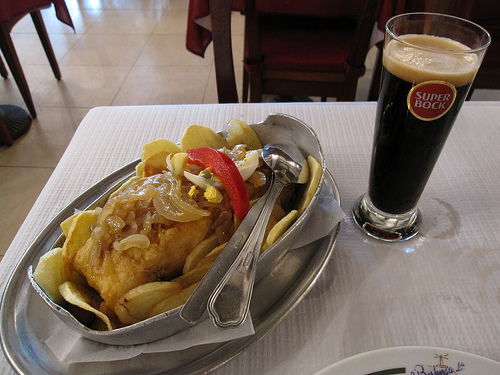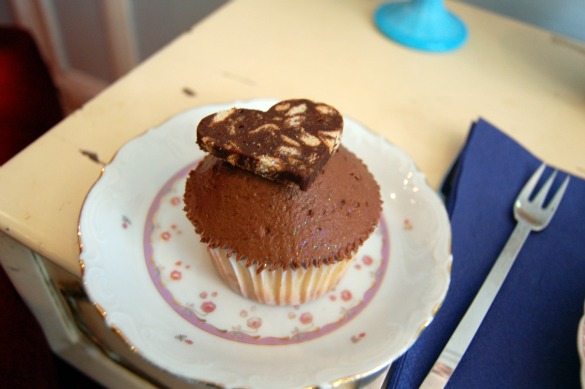Portuguese cuisine is not often ranked as one of the top European cuisines, but that may soon change. While the food has typically been characterized by an abundance of fish and a wide variety of spices,such as cinnamon, saffron, and vanilla, new chefs are now putting a more modern twist on many of the country’s traditional dishes, making this an exciting time to eat in Portugal. In Lisbon, the country’s capital and most cosmopolitan city, you’ll find everything from classic French or Italian food to Spanish tapas to Indian, sushi and Thai. But if you want to try the best of the Portuguese culinary offerings in the city, here are some things to eat and drink in Lisbon.
Fish
Fresh fish and shellfish is found on virtually every menu in Lisbon. Bacalhau (cod) dishes are everywhere – found grilled, broiled, poached, and in soups. At Bocca Lisboa, they serve a particularly good “salt cod duo – fillet at 52ºC and butter-braised tongues, poached egg and violet potato foam.” Other popular fish dishes include grilled sardines and horse mackerel, cuttlefish, grouper, turbot, or mullet. Ordering “arroz de marisco” will net you a dish of rice with various seafood including lobsters, shrimp, oysters, and crabs.
Meat
As popular as fish is in Lisbon, meat is equally prevalent, particularly pork. Portugal is well known for its Bairrada, or suckling pig, which can be found on menus all over Lisbon. You can also find pork roast with acorns or truffles, in sandwiches, in sausages like “chouriço” or “linguiça,” or cooked into stews like the “cozido à portuguesa.” Alheira, a smoked sausage made of pork, poultry meat, wheat bread and olive oil, seasoned with salt, garlic and paprika, is also very good.
Desserts
 The most typical desserts in Portugal are rice pudding and caramel custard, as well as cheeses (most Portuguese recipes don’t use cheese so it is only eaten before or after the meal). And of course, the most popular pastry is the pastel de nata, a small custard tart sprinkled with cinnamon. For a chocolate treat local to Lisbon, try “chocolate salami.” Melted chocolate is mixed with crushed up cookies, and then dried and sliced so it ends up looking like a slice of salami made of chocolate and cookies. Try it topping a cupcake at Tease, a late-night shop in the Barrio Alto.
The most typical desserts in Portugal are rice pudding and caramel custard, as well as cheeses (most Portuguese recipes don’t use cheese so it is only eaten before or after the meal). And of course, the most popular pastry is the pastel de nata, a small custard tart sprinkled with cinnamon. For a chocolate treat local to Lisbon, try “chocolate salami.” Melted chocolate is mixed with crushed up cookies, and then dried and sliced so it ends up looking like a slice of salami made of chocolate and cookies. Try it topping a cupcake at Tease, a late-night shop in the Barrio Alto.
Drinks
Like elsewhere in Portugal, you can find Portuguese wines, port, and beers on any restaurant menu, along with more international selections. The word for beer in Portuguese is cerveja, and the two main brands are Super Bock and Sagres, which go for 2-4 euros in more bars. You can also sample some of the country’s best wines at the ViniPortugal (located at the Ministry of Agriculture in Praça do Comerçio) which offers free wine tasting Tuesday-Saturday, between 11am and 7pm. To try some port, head to the Lisboa Solar tasting room.
Lisbon’s local drink is called ginjinha and is a liqueur made by infusing ginja berries in aguardente, the same grape spirit used to make port. The resulting cherry brandy is served in a shot-sized portion for about 1 euro each. Cafes all over the city serve it, but for the original, head to A Ginjinha, a small storefront bar at Largo de Sao Domingos in Rossio square.Ask for it “com ginja” (with a cherry in the glass) or “sem ginja’” for one without.
>> Read more about drinking in Portugal
Tips for dining in Lisbon
- Breakfast is usually very light and taken at a cafe. Have a coffee and some bread with butter or jam or a pastry to start you day. Lunch lasts an hour or more and is served between noon and 3pm. Most places serve dinner between 8 and 11pm, with 9pm being the time most locals dine. Some touristy restaurants will open at 7pm.
- Restauradores square is lined with restaurants, but many of them are geared towards tourists and thus a bit overpriced for the quality. Instead, head to the Barrio Alto or Chiado for some of the city’s most trendy and modern restaurants.
- You can find a bottle of decent wine for 8-15 euros in a restaurant or bar; higher quality bottles range from 20-30 euros. A nice bottle of table wine will be just a few euros at a wine shop.
- When you sit down to eat, you’ll be brought a basket of bread, a plate of sausage or in some cases, an extensive spread of meats and cheeses to start your meal. This is not free; you will be charged for what you eat. So if you’re on a tight budget, snack carefully or inquire about the price before you nibble. If you’re afraid the temptation might be too much, just ask the waiter to take it away.
- To tip, leave about 10% for good service.
Photos by: Berndt Rostad, Katie Hammel
 Vietnam is heaven for anyone who loves trying exotic dishes, who delights in the discovery of delicious and low-cost eats, and who lives to sample new street food. The food in Vietnam is delicious, healthy, and cheap and is an excellent way to better understand the culture. As
Vietnam is heaven for anyone who loves trying exotic dishes, who delights in the discovery of delicious and low-cost eats, and who lives to sample new street food. The food in Vietnam is delicious, healthy, and cheap and is an excellent way to better understand the culture. As